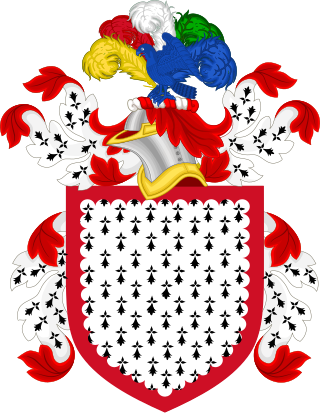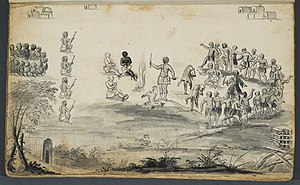
The Tuscarora are an Indigenous people of the Northeastern Woodlands in Canada and the United States. They are an Iroquoian Native American and First Nations people, based in New York and Ontario.
John Lawson was an English explorer, naturalist and writer. He played an important role in exploring the interior of colonial North Carolina, South Carolina and Georgia, publicizing his expeditions in a book. He founded two settlements in North Carolina: Bath and New Bern, both located on rivers in the coastal plain. He was killed by Tuscarora people during the outbreak of the Tuscarora War.
The Yamasee War was a conflict fought in South Carolina from 1715 to 1717 between British settlers from the Province of Carolina and the Yamasee, who were supported by a number of allied Native American peoples, including the Muscogee, Cherokee, Catawba, Apalachee, Apalachicola, Yuchi, Savannah River Shawnee, Congaree, Waxhaw, Pee Dee, Cape Fear, Cheraw, and others. Some of the Native American groups played a minor role, while others launched attacks throughout South Carolina in an attempt to destroy the colony.

The Pamlico were American Indians of North Carolina. They spoke an Algonquian language also known as Pamlico or Carolina Algonquian.
The Cape Fear Indians were a small, coastal tribe of Native Americans who lived on the Cape Fear River in North Carolina.
The Yamasees were a multiethnic confederation of Native Americans who lived in the coastal region of present-day northern coastal Georgia near the Savannah River and later in northeastern Florida. The Yamasees engaged in revolts and wars with other native groups and Europeans living in North America, specifically from Florida to North Carolina.
The Winyaw were a Native American tribe living near Winyah Bay, Black River, and the lower course of the Pee Dee River in South Carolina. The Winyaw people disappeared as a distinct entity after 1720 and are thought to have merged with the Waccamaw.
The Santee were a historic tribe of Native Americans that once lived in South Carolina within the counties of Clarendon and Orangeburg, along the Santee River. The Santee were a small tribe even during the early eighteenth century and were primarily centered in the area of the present-day town of Santee, South Carolina. Their settlement along the Santee River has since been dammed and is now called Lake Marion. The Santee Indian Organization, a state-recognized tribe within South Carolina claim descent from the historic Santee people but are not presently federally recognized by the Bureau of Indian Affairs.

The Cheraw people, also known as the Saraw or Saura, were a Siouan-speaking tribe of Indigenous people of the Southeastern Woodlands, in the Piedmont area of North Carolina near the Sauratown Mountains, east of Pilot Mountain and north of the Yadkin River. They lived in villages near the Catawba River. Their first European and African contact was with the Hernando De Soto Expedition in 1540. The early explorer John Lawson included them in the larger eastern-Siouan confederacy, which he called "the Esaw Nation."

John Barnwell (1671–1724), also known as Tuscarora Jack, was an Anglo-Irish soldier who emigrated to the Province of South Carolina in 1701. He led an army against the Tuscarora in 1711–1712. Later he served the colony as an official in talks with England in forming the government. He also worked to revive the relationship between the colony and its former allies the Yamasee.
The Congaree were a historic group of Native Americans who once lived within what is now central South Carolina, along the Congaree River. They spoke a language distinct from and not mutually intelligible with other local Siouan languages. The language today is generally considered unclassified, though, some linguists believe that the language was related to Catawba. The tribe joined the Catawba Nation in company of the Wateree several years after temporarily migrating to the Waccamaw River in 1732. During the middle of the eighteenth century, Congaree was considered one of the languages spoken within the Catawba Nation.

The Cusabo were a group of American Indian tribes who lived along the coast of the Atlantic Ocean in what is now South Carolina, approximately between present-day Charleston and south to the Savannah River, at the time of European colonization. English colonists often referred to them as one of the Settlement Indians of South Carolina, tribes who "settled" among the colonists.
The Waxhaw people were a tribe native to what are now the counties of Lancaster, in South Carolina; and Union and Mecklenburg in North Carolina, around the area of present-day Charlotte. The Waxhaw were related to other nearby Southeastern peoples, such as the Catawba people and the Sugeree. It is speculated that they were culturally influenced by the Mississippian culture.
The Sissipahaw or Haw were a Native American tribe of North Carolina. They are also variously recorded as Saxahapaw, Sauxpa, Sissipahaus, etc. Their settlements were generally located in the vicinity of modern-day Saxapahaw, North Carolina on the Haw River in Alamance County upstream from Cape Fear. They are possibly first recorded by the Spaniard Vendera in the 16th century as the Sauxpa in South Carolina. Their last mention in history is that the tribe joined the Yamasee against the English colonists in the Yamasee War of 1715. Some scholars speculate that they may have been a branch of the Shakori due to being so closely associated with that tribe but others disagree with this assumption.
The Cherokee people of the southeastern United States, and later Oklahoma and surrounding areas, have a long military history. Since European contact, Cherokee military activity has been documented in European records. Cherokee tribes and bands had a number of conflicts during the 18th century with Europeans, primarily British colonists from the Southern Colonies. The Eastern Band and Cherokees from the Indian Territory fought in the American Civil War, with bands allying with the Union or the Confederacy. Because many Cherokees allied with the Confederacy, the United States government required a new treaty with the nation after the war. Cherokees have also served in the United States military during the 20th and 21st centuries.

William Bull was a colonial American landowner and politician in the Province of South Carolina.

Native Americans living in the American Southeast were enslaved through warfare and purchased by European colonists in North America throughout the 17th, 18th, and 19th centuries, as well as held in captivity through Spanish-organized forced labor systems in Florida. Emerging British colonies in Virginia, Carolina, and Georgia imported Native Americans and incorporated them into chattel slavery systems, where they intermixed with slaves of African descent, who would eventually come to outnumber them. The settlers' demand for slaves affected communities as far west as present-day Illinois and the Mississippi River and as far south as the Gulf Coast. European settlers exported tens of thousands of enslaved Native Americans outside the region to New England and the Caribbean.
Francis Le Jau was a missionary to South Carolina with the Society for the Propagation of the Gospel (SPG). Born into a French Huguenot family in the La Rochelle region of France he later fled to England during the persecution of Huguenots after the revocation of the Edict of Nantes in 1685. He subsequently converted to Anglicanism and eventually graduated from Trinity College, Dublin. In 1700 he moved to St. Christopher's Island where he served for 18 months at the request of Bishop Henry Compton. From 1706 until his death in 1717 Le Jau served as a missionary to South Carolina based in Goose Creek.
Tom Blount was a Tuscarora chief best known for his role in the Tuscarora War. During the conflict, he allied with the British colonies of North Carolina and South Carolina. He and his allies in the northern band of the Tuscarora fought alongside British colonists against the southern band after Blount was promised full control over the Tuscarora and a permanent alliance with the British if they did so. In 1712, Blount was able to capture southern Tuscarora chief Hancock, who was executed by the colonists. This would ultimately lead to the demise of the southern Tuscarora. In 1713, Blount's band had all but secured victory. Members of the southern band began to move north to New York and joined the Iroquois tribe. There would still be small skirmishes and raids until 1715.







